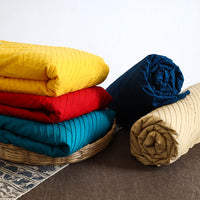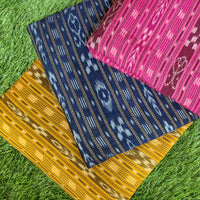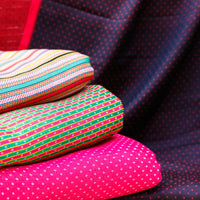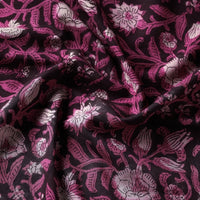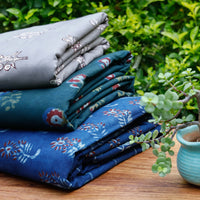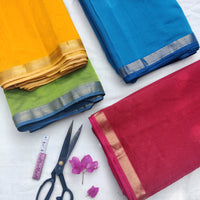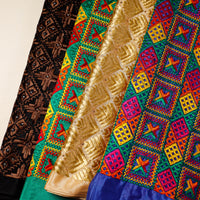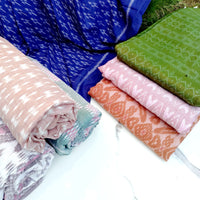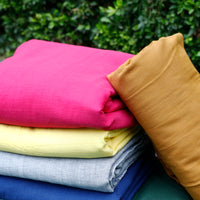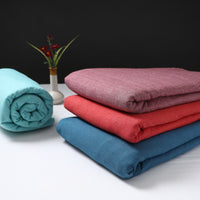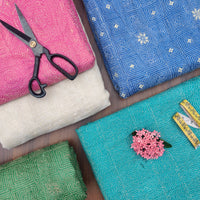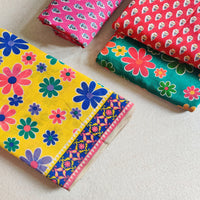The Legacy of Bengal Jamdani: A Timeless Weave
Introduction to Bengal Jamdani
Bengal Jamdani fabric is not just a textile; it’s a heritage, a living embodiment of centuries-old craftsmanship that continues to thrive in the modern world. Originating from the fertile plains of Bengal, this exquisite weave has long been celebrated for its intricate patterns, delicate textures, and the unparalleled skill of the artisans who bring it to life. At iTokri, we are proud to offer a carefully curated collection of Bengal Jamdani fabrics, each piece echoing the rich history, cultural significance, and the timeless appeal of this revered craft.
The Historical Roots of Jamdani Weaving
The art of Jamdani weaving dates back to the Mughal era, where it was patronized by the royal courts for its luxurious quality and elaborate designs. The name ‘Jamdani’ is derived from Persian, with ‘Jam’ meaning flower and ‘Dani’ meaning vase, signifying the floral patterns that are often woven into the fabric. Historically, Jamdani was produced in Dhaka (now in Bangladesh) and parts of West Bengal in India. The craft has survived through centuries of socio-political changes, adapting and evolving while retaining its traditional essence.
The Region and Communities Behind Jamdani
The Bengal region, particularly areas like Phulia in India and Dhaka in Bangladesh, is the heartland of Jamdani weaving. The communities here have been involved in this craft for generations, with the skills being passed down from one generation to the next. Phulia, in particular, is known for its skilled weavers who produce some of the most intricate Jamdani patterns. These artisans are not just weavers but custodians of a legacy that has been nurtured over centuries.
In these regions, weaving is more than just an occupation; it’s a way of life. The entire community often participates in the process, with men typically operating the looms and women assisting in thread preparation and other ancillary tasks. This communal involvement has ensured that the art of Jamdani weaving is kept alive, even in the face of modern industrial challenges.
The Process: A Labor of Love
The making of a Jamdani fabric is an intricate and labor-intensive process that requires both skill and patience. Unlike other forms of weaving, where patterns are pre-designed and executed on the loom, Jamdani designs are woven directly into the fabric by hand. The weaver sits in a pit loom, using fine threads of cotton or silk to create the delicate patterns that Jamdani is known for. Each motif is created using a supplementary weft technique, where the designs are added one thread at a time, making the process painstakingly slow but immensely rewarding.
It can take weeks, sometimes even months, to complete a single piece of Jamdani fabric, depending on the complexity of the design. This meticulous process ensures that each piece is unique, with no two Jamdani fabrics ever being exactly alike.
Cultural Significance of Jamdani
Jamdani fabric holds a special place in the cultural fabric of Bengal. Traditionally, it was worn by the elite and was often used in the making of elaborate sarees for special occasions. The motifs in Jamdani are symbolic, often inspired by nature, with common patterns including flowers, leaves, birds, and geometric shapes. Each design carries with it a story, a connection to the natural world, and a reflection of the weaver’s creativity.
The significance of Jamdani extends beyond its aesthetic appeal. It is a symbol of resistance and resilience, having survived colonial exploitation, industrial competition, and the challenges of modernity. Today, Jamdani is not just a fabric but a symbol of Bengal’s cultural identity and a testament to the enduring spirit of its artisans.
Jamdani in the Modern World
While Jamdani remains deeply rooted in tradition, it has also found its place in the modern world. Designers and fashion enthusiasts globally have embraced this fabric for its elegance, versatility, and the story it carries. Jamdani is no longer confined to traditional sarees; it is now used in a variety of fashion and home decor items, from scarves and stoles to curtains and cushion covers.
The global appeal of Jamdani is a testament to the timeless nature of this craft. It has transcended cultural boundaries, finding admirers across the world who appreciate the fine artistry and the rich history that each piece embodies.
Supporting Artisans through iTokri
At iTokri, we are committed to supporting the artisans who continue to practice the craft of Jamdani weaving. By sourcing our products directly from these communities, we ensure that the artisans receive fair compensation for their work, helping to sustain their livelihoods and preserve this ancient craft.
Each purchase at iTokri is more than just a transaction; it is a contribution to a larger cause. When you buy a piece of Jamdani fabric from us, you are not just acquiring a beautiful textile; you are helping to keep a centuries-old tradition alive. You are supporting a community of artisans who rely on this craft for their sustenance, and you are ensuring that future generations can continue to learn and practice this art.
The Human Stories Behind the Weave
The story of Jamdani is not just about the fabric but about the people who make it. Take, for example, the story of Ratan Das, a master weaver from Phulia. Ratan learned the craft from his father, who in turn had learned it from his father. For Ratan, weaving Jamdani is not just a job but a way to connect with his ancestors and keep their legacy alive. Despite the challenges posed by modern industrialization, Ratan continues to weave, motivated by his love for the craft and the pride he takes in his work.
Similarly, Amina Begum from Dhaka is one of the few women in her community who has mastered the art of Jamdani weaving. Amina’s story is one of resilience and empowerment. After losing her husband, she took up weaving to support her family. Today, she is a respected artisan in her community, known for her intricate designs and impeccable craftsmanship. Through her work, Amina has not only secured a livelihood for her family but has also become a role model for other women in her village.
These stories are just a glimpse into the lives of the artisans who create Jamdani fabrics. At iTokri, we believe in sharing these stories with our customers, allowing them to connect with the people behind the products and understand the significance of their purchase.
Why Choose iTokri for Jamdani Fabric?
iTokri is not just another e-commerce platform; it is a bridge between the global market and the artisans of India. We are deeply committed to authenticity, sustainability, and cultural preservation. When you shop with us, you are not just buying a product; you are becoming part of a movement that values craftsmanship, tradition, and ethical consumption.
Authenticity and Trust
Every piece of Jamdani fabric at iTokri is handpicked, ensuring that it meets our high standards of quality and authenticity. We work directly with artisan groups, eliminating middlemen and ensuring that the artisans receive fair compensation for their work. Our commitment to authenticity means that you can trust the quality of the products you purchase from us.
Cultural Preservation
At iTokri, we are passionate about preserving India’s rich cultural heritage. We curate a diverse array of products that celebrate the country’s traditional crafts, ensuring that these art forms continue to thrive in the modern world. By choosing iTokri, you are supporting the preservation of cultural traditions that have been passed down through generations.
Sustainability at Core
Sustainability is at the heart of everything we do at iTokri. From using recycled materials in our packaging to supporting eco-friendly crafts, we are committed to making a positive impact on the environment. Our Jamdani fabrics are made using natural dyes and traditional techniques that minimize waste, making them a sustainable choice for conscious consumers.
Community and Engagement
iTokri is more than just a marketplace; it is a community. We believe in fostering connections between artisans and customers, sharing the unique stories of the crafts and the people behind them. Through our storytelling and events, we bring people closer to the traditional arts of India, creating a space where heritage and modernity coexist.
Global Reach, Local Touch
While iTokri serves a global audience, our approach remains deeply rooted in local practices. We offer a platform where traditional techniques meet modern aesthetics, allowing customers worldwide to experience the beauty of Indian craftsmanship. Our global reach does not dilute our local touch; instead, it amplifies the voices of artisans from across India, bringing their work to a global stage.
Conclusion: Join the iTokri Family
At iTokri, we invite you to experience the warmth of Indian hospitality and the luxury of genuine handcrafted products. Our Bengal Jamdani collection is more than just a range of fabrics; it is a journey through history, culture, and craftsmanship. Each piece tells a story of skill, tradition, and a passion for sustainable art. When you choose iTokri, you are not just buying a product; you are supporting a brighter future for artisans across India.
बंगाल जमदानी: एक समयहीन बुनाई की धरोहर
बंगाल जमदानी कपड़ा केवल एक वस्त्र नहीं, बल्कि सदियों पुरानी कारीगरी की जीवंत मिसाल है, जो आज भी आधुनिक दुनिया में जीवित है। यह बेहतरीन बुनाई बंगाल के उपजाऊ मैदानों से उत्पन्न हुई है और इसे इसके जटिल डिज़ाइनों, नाजुक बनावट और कारीगरों की अद्वितीय कुशलता के लिए लंबे समय से सराहा गया है। iTokri पर, हम गर्व से बंगाल जमदानी कपड़ों का एक सावधानीपूर्वक क्यूरेट किया हुआ संग्रह प्रस्तुत करते हैं, जिनमें से प्रत्येक टुकड़ा इस प्राचीन कला का समृद्ध इतिहास, सांस्कृतिक महत्व और शाश्वत आकर्षण को दर्शाता है।
जमदानी बुनाई की कला मुगल युग से जुड़ी हुई है, जहाँ इसे इसके शानदार गुणवत्ता और जटिल डिज़ाइनों के लिए शाही दरबारों द्वारा संरक्षित किया गया था। 'जमदानी' नाम फारसी से लिया गया है, जिसमें 'जाम' का अर्थ फूल और 'दानी' का अर्थ फूलदान होता है, जो कि कपड़े में बुने गए फूलों के पैटर्न को दर्शाता है। ऐतिहासिक रूप से, जमदानी ढाका (अब बांग्लादेश में) और पश्चिम बंगाल, भारत के कुछ हिस्सों में उत्पादित किया जाता था।
बंगाल क्षेत्र, विशेष रूप से फुलिया और ढाका, जमदानी बुनाई का केंद्र है। यहाँ की कारीगरी पीढ़ी दर पीढ़ी चली आ रही है, और इन कारीगरों ने इस कला को जीवित रखा है, भले ही आधुनिक उद्योगों से चुनौती मिल रही हो।
जमदानी कपड़ा बनाने की प्रक्रिया बेहद जटिल और श्रमसाध्य होती है, जिसके लिए निपुणता और धैर्य की आवश्यकता होती है। हर डिज़ाइन हाथ से कपड़े में बुना जाता है, और इसमें महीनों लग सकते हैं। यह प्रक्रिया सुनिश्चित करती है कि हर जमदानी कपड़ा अद्वितीय हो।
जमदानी का सांस्कृतिक महत्व भी बहुत गहरा है। यह न केवल सुंदरता का प्रतीक है, बल्कि एक सांस्कृतिक पहचान भी है, जो औपनिवेशिक शोषण, औद्योगिक प्रतिस्पर्धा और आधुनिकता की चुनौतियों के बावजूद जीवित है।
iTokri पर, हम उन कारीगरों का समर्थन करने के लिए प्रतिबद्ध हैं जो जमदानी बुनाई की इस प्राचीन कला को जीवित रखे हुए हैं। हमारे साथ खरीदारी करके, आप न केवल एक सुंदर वस्त्र प्राप्त करते हैं, बल्कि इस सदियों पुरानी परंपरा को जीवित रखने में भी योगदान देते हैं।

















